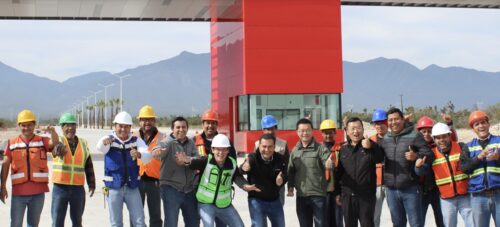Will Xiaomi be the world’s first smartphone company to launch an electric car?
Xiaomi, the consumer electronics and smartphone company that some compare to Apple, is preparing for a big electric car reveal this year. Consumers have been eager to see images of the new car, but all they've gotten so far are leaked photos of an early draft design.

The Chinese internet is agog with “Xiaomi’s new car.” On January 5, photographs appeared online of a camouflaged car standing near the Beijing headquarters of the consumer electronics firm and world’s second-largest smartphone maker Xiaomi, with speculation that this is the new car the company has been working on.
Then on January 23 during the Spring Festival holiday, design renderings purported to be of the new car appeared on the internet. The vehicle, showing the model number MS11, has a relatively round, streamlined shape like a coupe (a two-door passenger car with a sloping or truncated rear).
A few days later, another set of pictures leaked online of the car’s front and rear molding components, along with an image that apparently shows a cooperation agreement between Xiaomi and a company called Beijing Beijing Beiqi Auto Molding Technology 北京北汽模塑科技, a subsidiary of the state-owned auto manufacturer Beijing Automotive Group (BAIC).
Xiaomi founder Léi Jūn 雷军 has been driving the car project, quite literally: He has reportedly participated himself in test driving. Yet if the MS11 is indeed Xiaomi’s much hyped new car, which Lei said will be “the first car for young people,” online reactions to the design were unexcited, with some pointing out various similarities with the BYD Han “sporty sedan.”
Nevertheless, almost two years after Xiaomi announced in March 2021 that it was building electric vehicles, this seemed to be the very first look of Xiaomi’s new car.
Except it wasn’t. On January 24, Wáng Huà 王化, a Xiaomi public relations manager, stated that the leaked images were indeed related to a Xiaomi project, but only showed a very early design draft and not at all the final product. The leaked documents were confidential material from a second tier supplier of mold proofing at an early bidding stage.
China news, weekly.
Sign up for The China Project’s weekly newsletter, our free roundup of the most important China stories.
What we know about Xiaomi’s car so far
So we haven’t yet seen Xiaomi’s new car, but we do know some details of it that have been reported so far, and it seems impressive:
- The first model will be a sedan, with an SUV to follow within two years.
- The sedan will come in two models: the base model will use a 400V lithium iron phosphate battery, the BYD Blade Battery; and the top model will feature an 800V Qilin battery by CATL.
- The car will be equipped with five Light Detection and Ranging (lidar) remote sensors (EVs usually have two or three lidar sensors).
- The price of the sedan is likely to be above 300,000 yuan ($44,416).
With Lei Jun leading the charge, Xiaomi has made ample resources available: Lei has stated that Xiaomi will invest $10 billion in the car project over ten years. In the first three quarters of 2022, the company’s investments in EVs were 425 million yuan ($62.92 million), 611 million yuan ($90.46 million), and 829 million yuan ($122.73 million), respectively, and since the initial announcement in March 2021, the cumulative research and development costs have exceeded 5 billion yuan ($740.27 million).
The effects of this spending are clear to see:
- As of November 2022, Xiaomi has applied for more than 280 car and battery patents.
- The company has invested in various companies in related industries, such as lidar technology and autonomous driving (including acquiring the startup DeepMotion in 2021), and batteries, including WeLion New Energy Technology 卫蓝新能源, one of China’s leading solid state battery startups.
- In April 2022, construction commenced on the first phase of Xiaomi’s auto manufacturing facility at Yizhuang, just outside Beijing’s 5th Ring Road. The first phase of the project will be completed in June 2023, and the second stage in March 2025. The Yizhuang factory is expected to obtain an auto production license by July 2023.
- Xiaomi has poached staff from other companies. Just in 2022 this includes the former president of the Geely Research Institute, a former deputy general manager at SAIC-GM-Wuling, and a NIO regional manager.
Standing out in a crowd
The rationale for Xiaomi to build cars is obvious: smart EVs are the future of mobility, and they now form part of the smart ecosystem of cars, phones, and appliances. By developing EVs — for which the company is very well placed to develop in-house software — Xiaomi can lock in customers in every part of this highly lucrative ecosystem. This is the same reason why NIO and Geely are building smartphones, why Apple is building cars, and why Sony has just launched an EV joint venture (called Afeela) with Honda.
Yet success is not guaranteed for Xiaomi, despite all the hype. Competition in China’s EV industry is becoming fierce; this year alone there will be several highly competitive EVs to enter the market, including:
- BYD’s high-end EV brand Yángwāng (仰望) with two new models, the SUV U8 and “supercar” U9.
- New SUVs by NIO (ES6), AITO 问界 (M9), XPeng (G7), and Li Auto (L7).
- New sedans by VW (ID.7), BMW (i5), and Mercedes-Benz (EQG).
Update: After we published this story, Xiaomi said it had imposed a 1 million yuan ($149,000) penalty on a supplier for leaking early design drafts.






